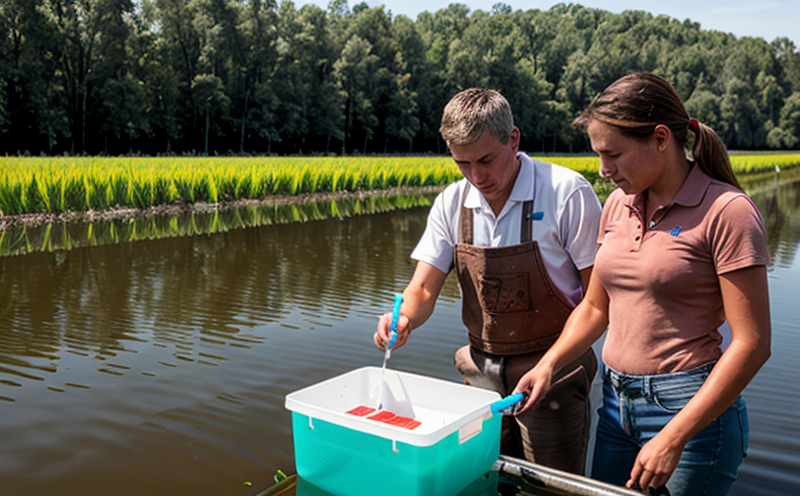Turbidity Testing in Agricultural Water
Turbidity testing is a critical aspect of water quality monitoring in agriculture. This process involves measuring the clarity or cloudiness of water by determining the amount of light scattered by suspended particles, which can include organic and inorganic materials such as clay, silt, and microorganisms.
In agricultural settings, water turbidity affects several important aspects including crop health, irrigation efficiency, and environmental sustainability. High levels of turbidity can lead to reduced sunlight penetration into the soil, affecting photosynthesis and plant growth. Additionally, it can increase the concentration of nitrates and other pollutants in the water, leading to potential contamination risks.
Water samples for turbidity testing must be collected from various points along the irrigation system or directly from sources such as rivers, lakes, and wells used for agricultural purposes. Proper specimen preparation is crucial; it involves filtering the sample through a 0.45 micrometer filter to remove larger particulates before performing the turbidity measurement.
The standard method of measuring turbidity is using a nephelometer, which follows ISO 7027:1993 guidelines. The instrument emits light into the water sample and measures the amount of light scattered by particles within it. This reading provides an index value that indicates how clear or cloudy the water is.
Acceptance criteria for turbidity in agricultural water vary depending on specific crop needs, but generally, a limit lower than 5 NTU (Nephelometric Turbidity Units) is recommended to ensure optimal growing conditions. Monitoring and maintaining these levels are essential components of sustainable agricultural practices.
To achieve accurate results, it's important to follow strict protocols during both sample collection and analysis. This includes minimizing disturbance of the water body, avoiding contamination of the sample, and ensuring proper calibration of the turbidity meter before each test run.
Regular monitoring allows farmers and agricultural experts to make informed decisions regarding irrigation practices and potential corrective actions if issues arise. By incorporating regular turbidity testing into their routine checks, they can help prevent costly damage to crops and protect both soil health and water resources.
Industry Applications
Turbidity testing plays a vital role across various sectors within agriculture and forestry. For instance, it helps in optimizing irrigation practices by ensuring that only clean water reaches the plants, thereby promoting healthier growth rates and yields. Properly conducted tests also aid in diagnosing problems related to nutrient leaching or contamination of groundwater sources.
In addition to enhancing crop productivity, turbidity testing contributes significantly towards environmental conservation efforts. By keeping track of changes in water quality over time, stakeholders can identify trends that might indicate broader ecological shifts or human activities causing pollution. This information is valuable for implementing targeted interventions aimed at preserving natural habitats and biodiversity.
- Optimizing irrigation systems
- Monitoring nutrient levels
- Preserving soil health
- Protecting aquatic ecosystems
- Ensuring compliance with regulatory standards
The accuracy of turbidity measurements is crucial for making reliable assessments. Therefore, investing in high-quality instrumentation and trained personnel ensures consistent results across different locations and times.
Competitive Advantage and Market Impact
- Enhanced decision-making capabilities through precise data collection
- Better resource management leading to cost savings
- Improved reputation among consumers who value sustainable practices
- Potential for innovation in precision agriculture techniques
By staying ahead of competition by leveraging advanced turbidity testing technologies, businesses can gain significant advantages. They become better positioned to meet stringent regulatory requirements while continuing to innovate and improve their offerings.
The global market for water quality testing instruments is expected to grow steadily over the coming years due to increasing awareness about environmental conservation and food safety concerns. Companies specializing in agricultural water quality monitoring stand to benefit greatly from this trend, especially those offering integrated solutions that combine multiple analytical capabilities into one compact device.
Use Cases and Application Examples
| Scenario | Action Taken | Result Achieved |
|---|---|---|
| A farmer notices unusually high turbidity levels in his irrigation water. | Takes a sample for analysis and uses it to adjust the frequency of cleaning filters used in the system. | The improved filtration reduces further contamination, leading to better crop health and yield increases. |
| An orchard owner wants to ensure that their fruit trees receive only clean water during spraying operations. | Installs a portable turbidity meter at the point of application for real-time monitoring. | This allows immediate adjustments to prevent any possible contamination, protecting both produce quality and consumer health. |
| A cooperative managing multiple dairy farms needs assurance that all water used in cleaning processes meets regulatory standards. | Conducts regular turbidity tests using lab-grade equipment. | The consistent compliance helps maintain high hygiene standards throughout the production cycle, enhancing overall product safety. |
These examples illustrate how effective turbidity testing can be applied practically within agricultural environments. Each instance showcases a unique challenge addressed through targeted interventions based on accurate test results.





